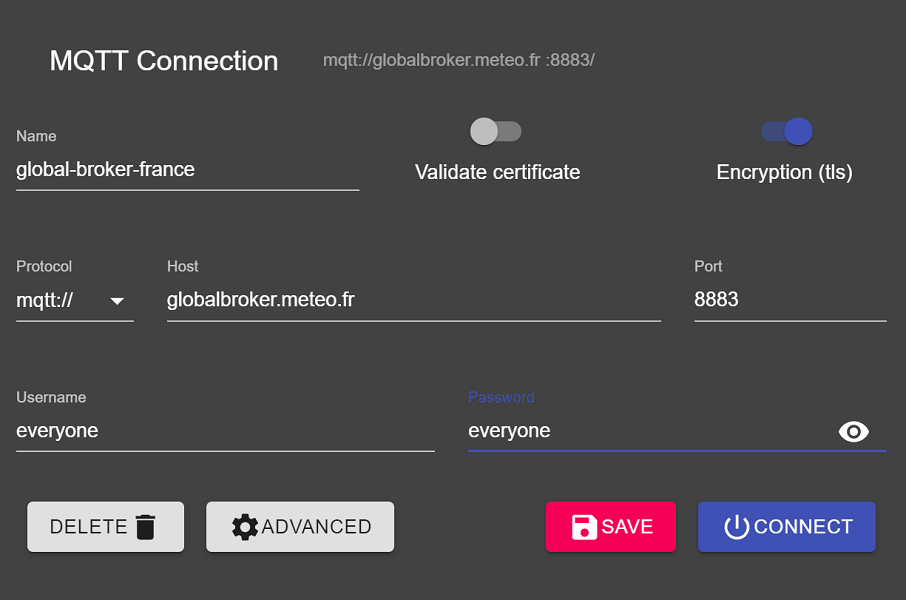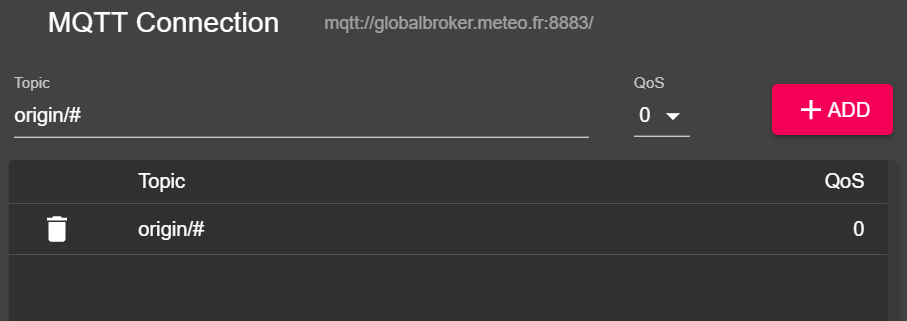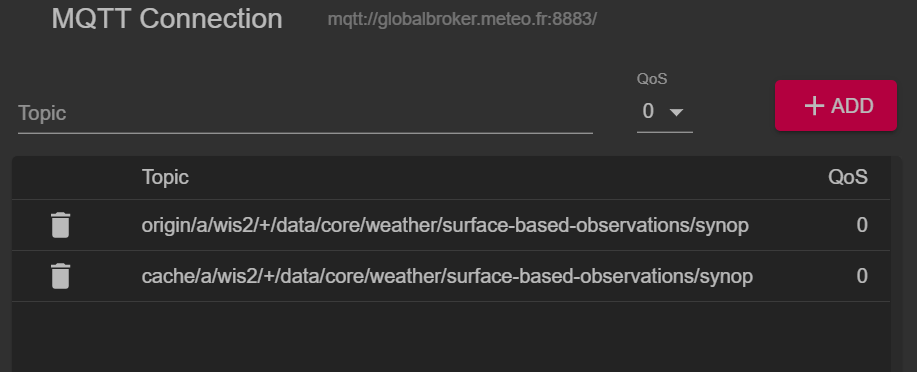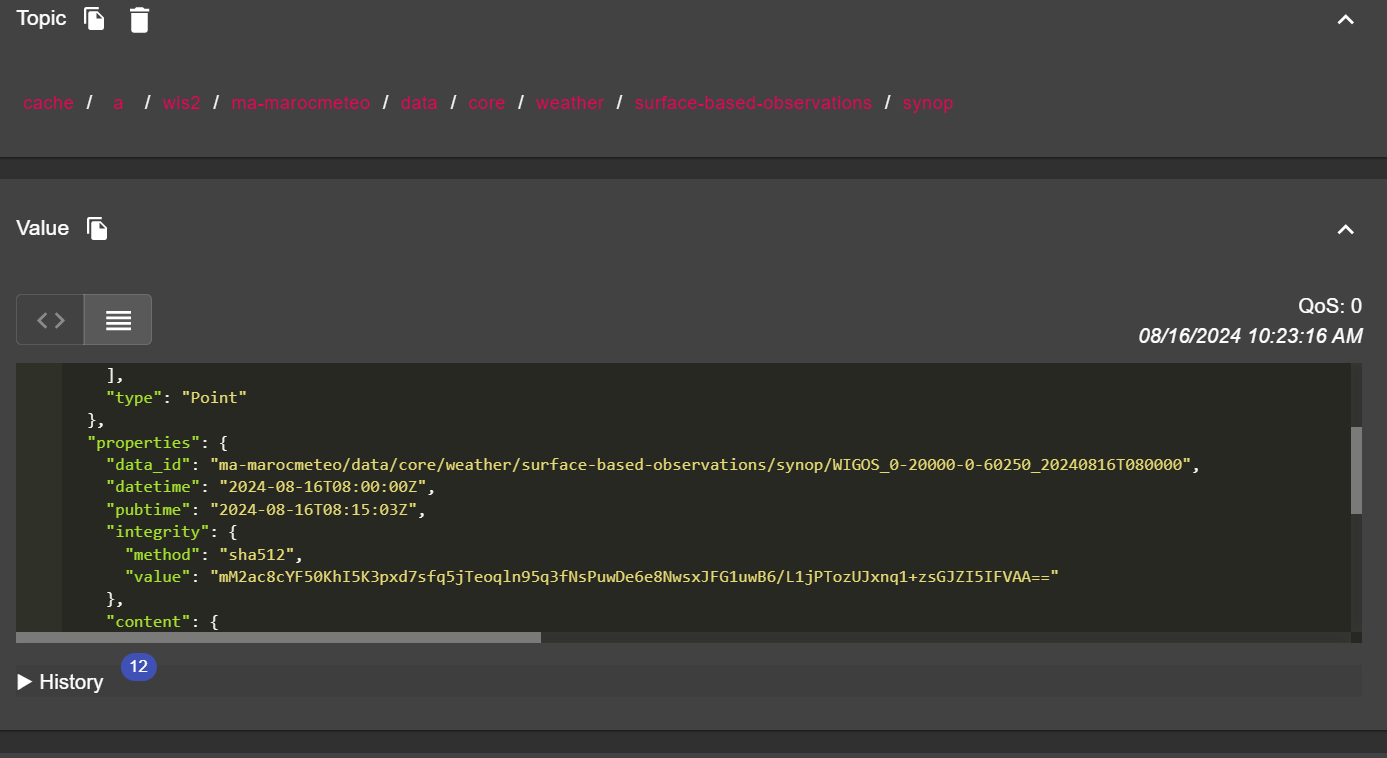Подключение к WIS2 через MQTT
Результаты обучения
К концу этой практической сессии вы сможете:
- подключаться к WIS2 Global Broker с использованием MQTT Explorer
- изучать структуру тем WIS2
- анализировать структуру уведомлений WIS2
Введение
WIS2 использует протокол MQTT для уведомления о доступности данных о погоде/климате/воде. WIS2 Global Broker подписывается на все WIS2 Nodes в сети и повторно публикует полученные сообщения. Global Cache подписывается на Global Broker, загружает данные из сообщения и затем повторно публикует сообщение в теме cache с новым URL. Global Discovery Catalogue публикует метаданные для поиска из брокера и предоставляет API для поиска.
Пример структуры уведомления WIS2 для сообщения, полученного по теме origin/a/wis2/br-inmet/data/core/weather/surface-based-observations/synop:
{
"id": "59f9b013-c4b3-410a-a52d-fff18f3f1b47",
"type": "Feature",
"version": "v04",
"geometry": {
"coordinates": [
-38.69389,
-17.96472,
60
],
"type": "Point"
},
"properties": {
"data_id": "br-inmet:synop-obs/WIGOS_0-20000-0-82022_20251114T180000",
"datetime": "2025-11-14T18:00:00Z",
"pubtime": "2025-11-14T20:49:31Z",
"metadata_id": "urn:wmo:md:br-inmet:synop-obs",
"integrity": {
"method": "sha512",
"value": "TBuWycx/G0lIiTo47eFPBViGutxcIyk7eikppAKPc4aHgOmTIS5Wb9+0v3awMOyCgwpFhTruRRCVReMQMp5kYw=="
},
"content": {
"encoding": "base64",
"value": "QlVGUgAA+gQAABYAACsAAAAAAAIAHAAH6AgPBgAAAAALAAABgMGWx1AAAM0ABOIAAAODM0OTkAAAAAAAAAAAAAAKb5oKEpJ6YkJ6mAAAAAAAAAAAAAAAAv0QeYA29WQa87ZhH4CQP//z+P//BD////+ASznXuUb///8MgAS3/////8X///e+AP////AB/+R/yf////////////////////6/1/79H/3///gEt////////4BLP6QAf/+/pAB//4H0YJ/YeAh/f2///7TH/////9+j//f///////////////////v0f//////////////////////wNzc3Nw==",
"size": 250
},
"wigos_station_identifier": "0-20000-0-82022"
},
"links": [
{
"rel": "canonical",
"type": "application/bufr",
"href": "http://wis2bra.inmet.gov.br/data/2025-11-14/wis/urn:wmo:md:br-inmet:synop-man/WIGOS_0-20000-0-82022_20251114T180000.bufr4"",
"length": 250
}
]
}
В этой практической сессии вы научитесь использовать инструмент MQTT Explorer для настройки подключения клиента MQTT к WIS2 Global Broker и отображения уведомлений WIS2.
MQTT Explorer — это полезный инструмент для просмотра и анализа структуры тем для заданного брокера MQTT и анализа публикуемых данных.
О MQTT
MQTT Explorer предоставляет удобный интерфейс для подключения к брокеру MQTT и изучения тем и структуры сообщений, используемых в WIS2.
На практике MQTT предназначен для машинного взаимодействия, где приложение или сервис подписывается на темы и обрабатывает сообщения программно в реальном времени.
Для работы с MQTT программно (например, на Python) вы можете использовать библиотеки клиентов MQTT, такие как paho-mqtt, чтобы подключаться к брокеру MQTT и обрабатывать входящие сообщения. Существует множество программных решений для клиентов и серверов MQTT в зависимости от ваших требований и технической среды.
Использование MQTT Explorer для подключения к Global Broker
Чтобы просматривать сообщения, публикуемые WIS2 Global Broker, вы можете использовать "MQTT Explorer", который можно скачать с веб-сайта MQTT Explorer.
Откройте MQTT Explorer и добавьте новое подключение к Global Broker, размещенному MeteoFrance, используя следующие данные:
- host: globalbroker.meteo.fr
- port: 8883
- username: everyone
- password: everyone

Нажмите кнопку 'ADVANCED', удалите предустановленные темы и добавьте следующие темы для подписки:
origin/a/wis2/#

Note
При настройке подписок MQTT вы можете использовать следующие подстановочные символы:
- Одноуровневый (+): подстановочный символ для одного уровня темы
- Многоуровневый (#): подстановочный символ для нескольких уровней темы
В данном случае origin/a/wis2/# подпишется на все темы под origin/a/wis2.
Нажмите 'BACK', затем 'SAVE', чтобы сохранить данные подключения и подписки. Затем нажмите 'CONNECT':
Сообщения должны начать появляться в вашей сессии MQTT Explorer следующим образом:

Теперь вы готовы начать изучение тем WIS2 и структуры сообщений.
Упражнение 1: Изучение структуры тем WIS2
Используйте MQTT для просмотра структуры тем под темами origin.
Question
Как мы можем определить WIS-центр, который опубликовал данные?
Нажмите, чтобы увидеть ответ
Вы можете нажать на окно слева в MQTT Explorer, чтобы развернуть структуру тем.
Мы можем определить WIS-центр, опубликовавший данные, по четвертому уровню структуры тем. Например, следующая тема:
origin/a/wis2/br-inmet/data/core/weather/surface-based-observations/synop
говорит нам, что данные были опубликованы WIS-центром с идентификатором центра br-inmet, который соответствует Instituto Nacional de Meteorologia - INMET, Бразилия.
Question
Как мы можем отличить сообщения, опубликованные WIS-центрами, которые управляют шлюзом GTS-to-WIS2, от сообщений, опубликованных WIS-центрами, которые управляют WIS2 Node?
Нажмите, чтобы увидеть ответ
Мы можем отличить сообщения, поступающие от шлюза GTS-to-WIS2, по идентификатору центра в структуре тем. Например, следующая тема:
origin/a/wis2/de-dwd-gts-to-wis2/data/core/I/S/A/I/01/sbbr
говорит нам, что данные были опубликованы шлюзом GTS-to-WIS2, управляемым Deutscher Wetterdienst (DWD), Германия. Шлюз GTS-to-WIS2 — это особый тип издателя данных, который публикует данные из Global Telecommunication System (GTS) в WIS2. Структура тем состоит из заголовков TTAAii CCCC для сообщений GTS.
Упражнение 2: Анализ структуры сообщений WIS2
Отключитесь от MQTT Explorer и обновите раздел 'Advanced', чтобы изменить подписку на следующие темы:
origin/a/wis2/+/data/core/weather/surface-based-observations/synopcache/a/wis2/+/data/core/weather/surface-based-observations/synop

Note
Подстановочный символ + используется для подписки на все WIS-центры.
Подключитесь снова к Global Broker и дождитесь появления сообщений.
Вы можете просмотреть содержимое сообщения WIS2 в разделе "Value" справа. Попробуйте развернуть структуру тем, чтобы увидеть различные уровни сообщения, пока не достигнете последнего уровня, и изучите содержимое одного из сообщений.
Question
Как мы можем определить временную метку публикации данных? И как мы можем определить временную метку сбора данных?
Нажмите, чтобы увидеть ответ
Временная метка публикации данных содержится в разделе properties сообщения с ключом pubtime.
Временная метка сбора данных содержится в разделе properties сообщения с ключом datetime.

Question
Как мы можем загрузить данные по URL, указанному в сообщении?
Нажмите, чтобы увидеть ответ
URL содержится в разделе links с rel="canonical" и определяется ключом href.
Вы можете скопировать URL и вставить его в веб-браузер, чтобы загрузить данные.
Упражнение 3: Сравнение тем 'origin' и 'cache'
Убедитесь, что вы все еще подключены к Global Broker, используя подписки на темы origin/a/wis2/+/data/core/weather/surface-based-observations/synop и cache/a/wis2/+/data/core/weather/surface-based-observations/synop, как описано в Упражнении 2.
Попробуйте найти сообщение для одного и того же идентификатора центра, опубликованное как в темах origin, так и в темах cache.
Question
В чем разница между сообщениями, опубликованными в темах origin и cache?
Нажмите, чтобы увидеть ответ
Сообщения, опубликованные в темах origin, являются оригинальными сообщениями, которые Global Broker повторно публикует из WIS2 Nodes в сети.
Сообщения, опубликованные в темах cache, — это сообщения для данных, которые были загружены Global Cache. Если вы проверите содержимое сообщения из темы, начинающейся с cache, вы увидите, что ссылка 'canonical' была обновлена на новый URL.
В сети WIS2 существует несколько Global Cache, поэтому вы получите одно сообщение от каждого Global Cache, который загрузил сообщение.
Global Cache загружает и повторно публикует только сообщения, которые были опубликованы в иерархии тем ../data/core/....
Заключение
Поздравляем!
В этой практической сессии вы узнали:
- как подписываться на сервисы WIS2 Global Broker с использованием MQTT Explorer
- структуру тем WIS2
- структуру уведомлений WIS2
- разницу между основными и рекомендованными данными
- структуру тем, используемую шлюзом GTS-to-WIS2
- разницу между сообщениями Global Broker, опубликованными в темах
originиcache